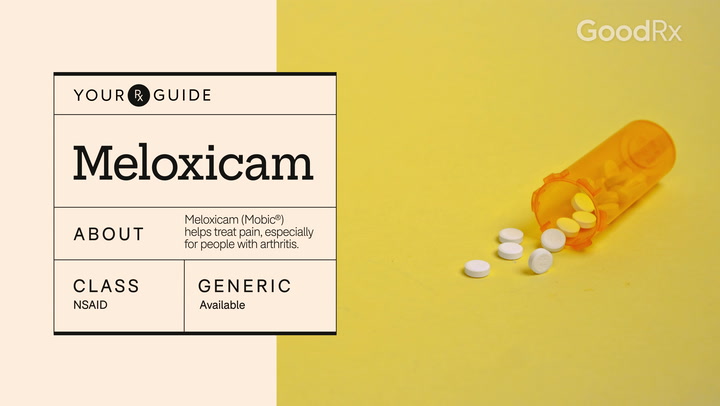
7 Meloxicam Interactions You Should Know About
Key takeaways:
Meloxicam (Mobic) is a prescription nonsteroidal anti-inflammatory drug (NSAID). Several medications and substances interact with it.
You should avoid taking meloxicam with alcohol, blood thinners, or other NSAIDs. Taking meloxicam with these medications raises your risk for stomach ulcers and bleeding.
Other meloxicam interactions include some antidepressants and certain blood pressure medications. Meloxicam can also raise lithium (Lithobid) and methotrexate (Trexall) levels. Your prescriber may OK these combinations in some cases, but you should keep an eye out for signs that an interaction is causing a problem.
Table of contents

Meloxicam (Mobic) is a prescription nonsteroidal anti-inflammatory drug (NSAID). It helps reduce pain and swelling caused by osteoarthritis (OA) and rheumatoid arthritis (RA).
It’s helpful to know about the risks of meloxicam before you start taking it. This includes what medications and substances it can interact with. Let’s take a look at seven meloxicam interactions you should be aware of.
1. Ibuprofen, aspirin, and other NSAIDs
Common over-the-counter (OTC) NSAIDs include ibuprofen (Advil, Motrin), naproxen (Aleve, Naprosyn), and aspirin. You shouldn’t take meloxicam and ibuprofen (or other NSAIDs) together unless your prescriber tells you to do so.
Search and compare options
Taking more than one NSAID isn’t likely to improve your symptoms more than taking just one. But it can raise your risk of side effects, such as stomach ulcers and bleeding.
Keep in mind that NSAIDs are often included in OTC cold and flu medications and sleep aids. Check the label carefully or ask a pharmacist for assistance to make sure you aren’t taking extra NSAIDs you may not be aware of.
If meloxicam isn’t working well for your pain on its own, talk to your prescriber. They can recommend a medication that’s safe to take along with it. Or they may want you to try a different medication to manage your arthritis symptoms.
2. Alcohol
It’s best to avoid combining meloxicam and alcohol. Drinking alcohol while taking NSAIDs (including meloxicam) raises your risk of gastrointestinal (GI) bleeds and ulcers. This is especially true if you have a history of peptic ulcer disease (PUD) or GI bleeding.
If you’re concerned about your ability to avoid alcohol while taking meloxicam, speak with your healthcare team. They can help you find ways to reduce your drinking, if needed. Or they can suggest an alternative to meloxicam that’s safer for you.
3. Blood thinners
Blood thinners are medications that treat and prevent unwanted blood clots. They include anticoagulant and antiplatelet medications. Meloxicam isn’t considered a blood thinner, but it can make it harder for your blood to clot. Combining meloxicam with blood thinners can raise your risk of bleeding. The combination can also raise the risk of a heart attack if you’ve had one in the past. So it’s best to avoid taking meloxicam and blood thinners at the same time.
Examples of common blood thinners include:
Apixaban (Eliquis)
Dabigatran (Pradaxa)
Rivaroxaban (Xarelto)
Warfarin (Coumadin, Jantoven)
Clopidogrel (Plavix)
Prasugrel (Effient)
Ticagrelor (Brilinta)
Let your prescriber know if you’re taking a blood thinner before starting meloxicam. A different arthritis treatment may be a safer option for you.
Meloxicam side effects: Learn about common and rare meloxicam side effects and how to manage them.
What’s it like to take meloxicam? Read first-hand accounts of how it feels to take meloxicam.
Meloxicam vs. ibuprofen: Here’s how these two anti-inflammatory medications compare.
4. Certain blood pressure medications
Meloxicam may make some blood pressure medications less effective. Taking meloxicam with certain blood pressure medications can also raise your risk of kidney damage. Meloxicam and other NSAIDs can restrict blood flow to the kidneys. Taking them with blood pressure medications that run through the kidneys may lead to acute (sudden) kidney injury.
Blood pressure medications that can interact with meloxicam include:
Angiotensin II receptor blockers (ARBs), such as losartan (Cozaar)
Angiotensin-converting enzyme (ACE) inhibitors, such as lisinopril (Zestril)
Beta blockers, such as metoprolol (Lopressor, Toprol XL)
Diuretics (“water pills”), such as hydrochlorothiazide and furosemide (Lasix)
Your prescriber may suggest avoiding meloxicam if you take certain blood pressure medications. But they may still prescribe both medications despite the interaction. In this case, they may keep a closer eye on your blood pressure and kidney function in case any issues occur.
5. Certain antidepressants
Some antidepressants can raise your risk of bleeding. If you take them with meloxicam, your bleeding risk goes up, since both medications have this potential side effect.
Antidepressants that can raise your bleeding risk include:
Selective serotonin reuptake inhibitors (SSRIs), such as sertraline (Zoloft) and escitalopram (Lexapro)
Serotonin and norepinephrine reuptake inhibitors (SNRIs), such as venlafaxine (Effexor XR) and duloxetine (Cymbalta)
It’s likely OK to take meloxicam with these antidepressants. But make sure your prescriber OKs it, and keep an eye out for signs of bleeding. Report mild bleeding, such as when brushing your teeth, to your prescriber. But for severe bleeding, such as blood in your urine, stool, or vomit, seek emergency care right away.
6. Lithium
Lithium (Lithobid) is a mood stabilizer that treats certain mental health conditions. Many medications interact with lithium, including NSAIDs. Meloxicam slows the rate at which your kidneys get rid of lithium. This can increase lithium levels in your body and raise your risk of lithium side effects, including lithium toxicity.
You may be able to take meloxicam and lithium together if your prescriber OKs it. But your prescriber may check your lithium levels more often to make sure they’re within a safe range. Be sure to keep your regular appointments so they can catch any issues that arise.
Signs of high lithium levels can include confusion, slurred speech, or blurred vision. In severe cases, you may experience blackouts or seizures. Seek immediate medical attention if you notice any signs or symptoms of high lithium levels.
7. Methotrexate
Like meloxicam, methotrexate (Trexall) is often prescribed for RA symptoms. But these medications can interact with one another.
Meloxicam can raise methotrexate levels in your body. As with lithium, this can raise the risk of methotrexate side effects or toxicity. It’s best to avoid taking meloxicam with high doses of methotrexate. But your prescriber may recommend both medications if you’re taking a low methotrexate dosage.
If you’re taking meloxicam and methotrexate, keep an eye out for any side effects, such as nausea or diarrhea. If your symptoms seem severe or life-threatening, call 911 or seek emergency care.
Frequently asked questions
It’s likely safe to take Tylenol (acetaminophen) with meloxicam. Tylenol isn’t an NSAID, so it shouldn’t raise your risk of bleeding or stomach ulcers if you take it with meloxicam. But if meloxicam isn’t working well for your pain, it’s best to let your prescriber know before taking additional medication. There could be something else going on that requires expert care.
Meloxicam lasts in your body for quite some time after taking it. It can take 3 to 4 days to clear meloxicam after your last dose. So it’s best to wait at least 4 days after your last meloxicam dose to drink alcohol. Talk to your prescriber about whether a drink or two may be safe for you on occasion.
The bottom line
Meloxicam (Mobic) is a prescription nonsteroidal anti-inflammatory drug (NSAID). Taking meloxicam with alcohol or other NSAIDs can raise your risk of stomach ulcers. There’s an increased risk of bleeding if you take meloxicam with blood thinners or some antidepressants.
Meloxicam interacts with some blood pressure medications. It can make them less effective and raise your risk of kidney problems. Your lithium (Lithobid) or methotrexate (Trexall) levels may go up if you take them with meloxicam. Your prescriber may OK these combinations, but they’ll likely keep an eye out for signs that an interaction is causing a problem. Be sure to keep your regular appointments to help protect your health.
Why trust our experts?



References
Aurobindo Pharma Limited. (2024). Meloxicam - meloxicam tablet [package insert].
Dixit, M., et al. (2010). Significant acute kidney injury due to non-steroidal anti-inflammatory drugs: Inpatient setting. Pharmaceuticals.
Hou, P.-C., et al. (2020). Risk of intracranial hemorrhage with concomitant use of antidepressants and nonsteroidal anti-inflammatory drugs: A nested case-control study. Annals of Pharmacotherapy.
MedlinePlus. (2024). Blood thinners.
National Kidney Foundation. (2024). Acute kidney injury (AKI).
Olsen, A.-M. S., et al. (2015). NSAID use with risk of bleeding and cardiovascular events in patients receiving antithrombotic therapy. American College of Cardiology.
Zeiss, R., et al. (2021). Risk of bleeding associated with antidepressants: Impact of causality assessment and competition bias on signal detection. Frontiers in Psychiatry.
Was this page helpful?
Related Articles
Browse medications
View AllResearch prescriptions and over-the-counter medications from A to Z, compare drug prices, and start saving.













